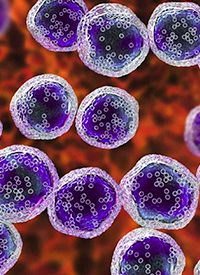Article
Pirtobrutinib Elicits 50% Response Rate in BTK-Pretreated MCL
Author(s):
Pirtobrutinib demonstrated potent antitumor activity and a low incidence of adverse effects in patients with BTK-pretreated and -naïve mantle cell lymphoma.
Mantle Cell Lymphoma

Pirtobrutinib (LOXO-305) demonstrated potent antitumor activity and a low incidence of adverse effects (AEs) in patients with BTK-pretreated and -naïve mantle cell lymphoma (MCL), according to updated findings from the phase 1/2 BRUIN trial (NCT03740529) presented at the 2022 Pan Pacific Lymphoma Conference.
Among BTK-pretreated patients (n = 100), the overall response rate (ORR) was 51% (95% CI, 41%-61%) and consisted of complete responses ([CRs] n = 25; 25%), partial responses ([PRs] n = 26; 26%), and stable disease ([SD] n = 16; 16%). Among BTK-naïve patients (n = 11), the ORR was 82% (95% CI, 48%-98%) and consisted of CRs (n = 2; 18%), PRs (n = 7; 64%), and SD (n = 1; 9%).
Notably, efficacy was also seen in patients with prior stem cell transplant (n = 28; ORR, 64%; 95% CI, 44%-81%) and prior CAR T-cell therapy (n = 6; ORR, 50%; 95% CI, 12%-88%).
“Pirtobrutinib demonstrates promising efficacy in MCL patients previously treated with BTK inhibitors, a population with extremely poor outcomes,” the study authors wrote in the poster.
Progression on covalent BTK inhibitors is associated with an extremely poor prognosis in MCL, and mechanisms of resistance are not entirely understood.
Pirtobrutinib is a highly potent and selective noncovalent BTK inhibitor that has nanomolar potency against wild-type and C481-mutant BTK in cell and enzyme assays. Additionally, favorable pharmacologic properties allow sustained BTK inhibition throughout dosing intervals.
The BRUIN study consisted of a phase 1 dose-escalation and -expansion portion, which evaluated between 25 mg and 300 mg of pirtobrutinib daily and a phase 2 portion, which evaluated 200 mg of pirtobrutinib daily, both in 28-day cycles.
Eligible patients (n = 618) were at least 18 years of age and had an ECOG performance status between 0 and 2, pretreated chronic lymphocytic leukemia (CLL) or other B-cell non-Hodgkin lymphoma, and active disease requiring treatment.
Key end points included safety/tolerability, determination of the maximum tolerated dose (MTD) and recommended phase 2 dose (RP2D), pharmacokinetics, and efficacy according to ORR and duration of response based on disease criteria.
The safety population included 296 patients with CLL/small lymphocytic lymphoma, 134 with MCL, and 188 with other malignancies.
The median patient age in the MCL population was 70 years (range, 46-88). Most patients were male (n = 104; 78%), had classic histology (n = 108; 81%), and an ECOG performance status of 0 (n = 82; 61%). The median number of prior lines of therapy was 3 (range, 1-9).
Most patients had received prior BTK inhibition (n = 120; 90%), CD20 inhibition (n = 130; 97%), and chemotherapy (n = 122; 91%). The primary reason for discontinuing BTK inhibition was progressive disease (n = 100; 83%).
Additional efficacy findings demonstrated that 60% (n = 26/60) of responses were ongoing at a median follow-up of 8.2 months (range, 1.0-27.9) for responding patients.
Regarding safety, no dose-limiting toxicities were reported, and the MTD was not reached. Most patients (96%) received at least 1 dose of pirtobrutinib at or above the RP2D of 200 mg daily, and only 1% of patients (n = 6) permanently discontinued treatment because of treatment-related AEs (TRAEs).
Common any-grade treatment-emergent AEs (TEAEs)included fatigue (23%), diarrhea (19%), neutropenia (18%), and contusion (17%). Any-grade treatment-related fatigue (9%), diarrhea (8%), neutropenia (10%), and contusion (12%) also occurred.
TEAEs of special interest of any grade included bruising (22%), rash (11%), arthralgia (11%), hemorrhage (8%), hypertension (7%), and atrial fibrillation/flutter (2%). The incidence of these TRAEs was 15%, 5%, 3%, 2%, 2%, and less than 1%, respectively.
“Favorable safety and tolerability are consistent with the design of pirtobrutinib as a highly selective and non-covalent (reversible) BTK inhibitor,” the study authors wrote.
The randomized, global, phase 3 BRUIN MCL-321 trial (NCT04662255) comparing pirtobrutinib with investigator’s choice of covalent BTK inhibitor in BTK-naïve, relapsed MCL is ongoing.
Reference
Lewis K, Wang ML, Shah NN, et al. Pirtobrutinib, a highly selective, non-covalent (REVERSIBLE) BTK inhibitor in previously treated mantle cell lymphoma: updated results from the phase 1/2 BRUIN study. Presented at: 2022 Pan Pacific Lymphoma Conference; July 18-22, 2022; Koloa, HI. https://bit.ly/3OhW0qW








